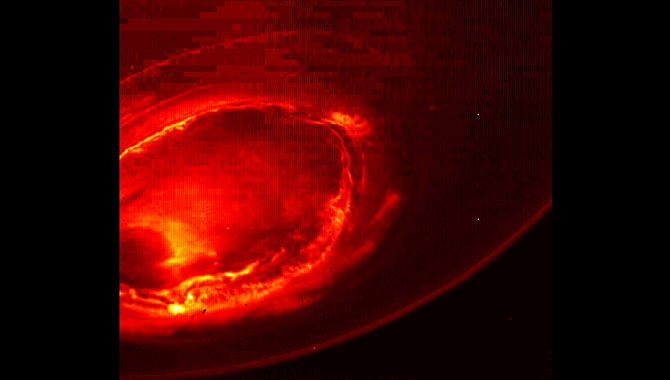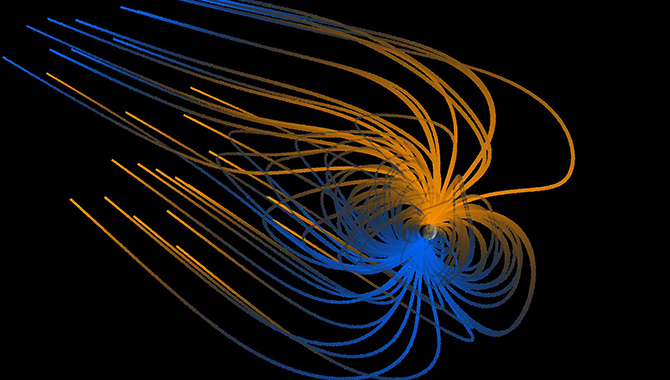
On its final approach to Jupiter, Juno passed the gas giant’s Galilean moons: first Calisto, then Ganymede, then Europa, and finally Io. This image of the four satellites was taken by the spacecraft’s JunoCam before the science instruments were turned off for the Jupiter orbit insertion maneuver.
Image Credit: NASA/JPL-Caltech/SwRI/MSSS
NASA’s Juno spacecraft successfully entered orbit around Jupiter on July 4, 2016, and is set to begin unlocking the mysteries of the gas giant and the origins of our solar system.
Jupiter, said Scott Bolton, Juno principal investigator from Southwest Research Institute (SwRI), “is the king of our solar system. This is it. The largest planet: more massive than all the other planets and everything else in our solar system combined, other than the sun.” He added, “What Juno’s about is looking beneath [the] surface. We’ve got to go down and look at what’s inside, see how it’s built, how deep do these features go, learn about its real secrets.”
Juno, a spin-stabilized polar-orbiting spacecraft, is only the second mission to orbit around Jupiter and the first to penetrate beneath the planet’s cloud cover to explore its interior. The spacecraft launched on an Atlas V rocket from Cape Canaveral, FL, in August 2011. It flew out past Mars, where it fired its main engine twice before looping back and getting a gravity assist from Earth that provided 70% of the velocity that the spacecraft had gotten from its launch vehicle. That extra burst of speed enabled Juno to travel all the way to Jupiter. On June 25 of this year, the spacecraft crossed the bow shock from interstellar space into the Jovian magnetic field.
A crucial moment in the mission took place days later on July 4, when the spacecraft fired up its main engine and began the process of entering orbit around Jupiter. The insertion process wasn’t simple. Due to the 48-minute lag time in communication between Juno and Earth, the entire Jupiter orbit insertion (JOI) maneuver had to be performed autonomously. In addition, the solar-powered spacecraft had to conduct the JOI while pointing away from the sun, relying on battery power. It then had to hit a target only tens of kilometers wide.
“We’re going to hit that within 1.2 seconds after a journey of 1.7 billion miles. That tells you just how good our navigation team is,” said Rick Nybakken, Juno project manager at the Jet Propulsion Laboratory (JPL), shortly before the JOI.
“To put a spacecraft in orbit around the most intense planet in the solar system, you’ve got to fire the main engine at exactly the right time, at exactly the right place. That’s not easy,” said Guy Beutelschies, director of interplanetary missions at Lockheed Martin. Despite the challenge, the maneuver was successful. “We’ve got the spacecraft pointed back at the sun and the antenna back on Earth,” he said.
Juno faced additional hazards during the insertion process, starting with exposure to the extreme radiation of Jupiter’s belts. “They’re the equivalent idea of what we have around Earth called Van Allen radiation belts, but Jupiter’s are on steroids. They’re a very serious hazard,” said Bolton.
“Juno is going to go into the scariest part of the scariest place that we know about—because we don’t know about it. It’s the part of Jupiter’s radiation environment where nobody has ever been,” said Heidi Becker, Juno’s radiation monitoring lead investigator, speaking before the JOI. “[T]hese are high-energy electrons that are so energetic they’re moving at the speed of light because Jupiter’s magnetic field has accelerated them to the point where they will go right through a spacecraft and strip the atoms apart inside your electronics.”
Knowing millions of these electrons would bombard Juno during the JOI, the team took measures to protect the spacecraft’s vital electronics and science instruments. First, the spacecraft followed a polar orbit that took it over the north pole through a less intense section of the radiation before it slid beneath the radiation belts in the equatorial region, and then exited through a section of radiation over the south pole. The spacecraft will follow a similar trajectory during its science-collection phase, which begins this fall.
“[O]ur trajectory allows Juno to fly around the really harsh parts of the radiation belts near the equator and duck underneath when we get very close to the planet. But we still have these very high-intensity regions near the planet that we can’t avoid, and later in the mission we get further and further into the equatorial region. And that’s where we’re really going to start to degrade,” said Becker.
To help shield Juno during that phase of the mission, the team built a radiation vault constructed of titanium a half-inch thick. Without that vault, said Becker, “Juno would experience something equivalent to a human being having 100 million x-rays in less than a year.” The vault reduces the radiation dose by a factor of approximately 800.
The radiation vault is one of two signature innovations for the mission. The second is the spacecraft’s massive solar arrays. Juno is the first solar-powered vehicle to operate so far from the sun. To maximize sun exposure, its solar arrays house 18,698 solar cells. Despite the fact that the spacecraft will receive only one twenty-fifth of the sunlight at Jupiter that it would on Earth, the solar arrays will provide 500 watts of power.
A second hazard during JOI was the little-known rings around Jupiter. Consisting of debris such as dust and meteorites, the horizontal rings have vertical extensions that are not well understood. The spacecraft was forced to pass through the rings during JOI with its engine door open to facilitate an uninterrupted engine burn. Had a speck of dust penetrated the forward-facing nozzle, the results could have been disastrous.
“The more you know about the mission, you know just how tricky this was. And to have it be flawless…I really can’t put it into words,” said Diane Brown, Juno program executive at NASA Headquarters.
Now in orbit around the gas giant, Juno’s first trip around Jupiter will take 53 days, as opposed to the 14-day orbit it will adopt during its science-collection phase. That phase will begin on October 19, following a final engine burn.
“And now the fun begins!” said Bolton. “The science.” The mission features nine science instruments designed to study Jupiter’s structure, atmospheric composition, gravitational and magnetic fields, polar magnetosphere, and auroras. Its findings will help answer such questions as how, when, and where Jupiter was formed, and reveal new information about the early evolution of our solar system.
Juno is managed by JPL. The spacecraft was built by Lockheed Martin Space Systems as part of NASA’s New Frontiers Program, which is managed at Marshall Space Flight Center (MSFC) for the Science Mission Directorate.
Read a previous APPEL News article about the Juno mission and science instruments.
Watch a video of Juno’s final approach to Jupiter. The footage captures Jupiter’s Galilean moons in motion around the gas giant, which has never before been seen.









